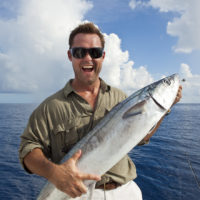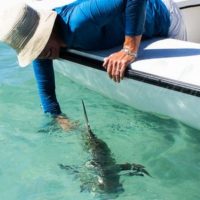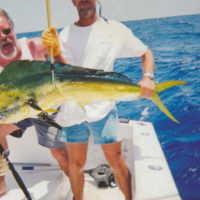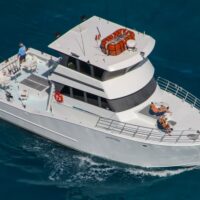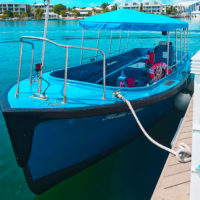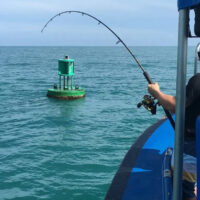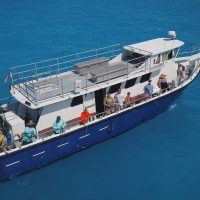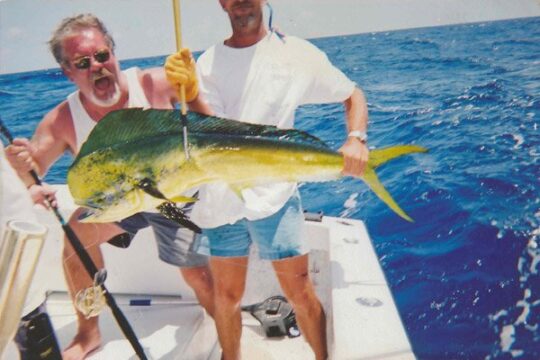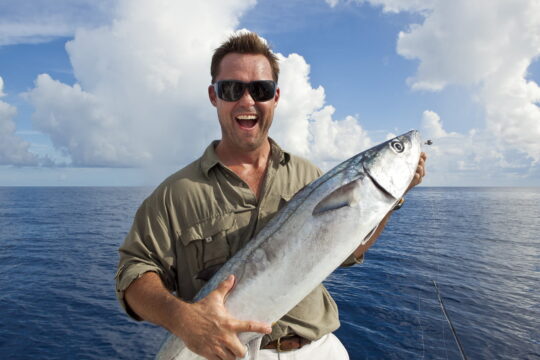Fishing for Atlantic Bonito in Key West
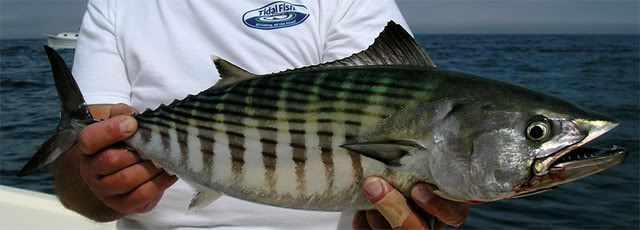
The Atlantic Bonito, also called True Bonito and Northern Bonito, is a fast-swimming open-water gamefish from the Tuna family. When fishing in Key West, Atlantic Bonito are most commonly found when trolling for big gamefish in the coastal offshore Atlantic waters. They exciting to encounter, often seen in large schools working balls of baitfish under circling birds, with many fish leaping from the water and delivering aggressive, rapid-fire hits to surface lures or floating live baits. (Florida Record: 6lbs 8oz)
Atlantic Bonito (Sarda sarda)
The Atlantic Bonito is a member of the Scombridae family which also includes Mackerel, Tuna and Spanish Mackerel. They look similar to the related species Little Tunny (Euthynnus alletteratus) and Skipjack Tuna (Katsuwonus pelamis). The name Bonito is often used interchangeably between the 3 species, and fishermen often confuse them for each other, but the 3 types of fish can be distinguished by coloring, fin formation, and body structure.
Atlantic Bonito are differentiated from Tuna by their compressed rather than round bodies, the lack of teeth on the roof of their mouth, and differences in coloration. Atlantic Bonito typically have metallic grey or grey-green backs, with dark wavy stripes above the lateral line and extending forward to below the first spine of the dorsal fin. The sides lighten in color down to a grey-white belly. The fish may also have vertical stripes of grey on their sides that fade after death. In Florida waters, Atlantic Bonito commonly run about 4-5lbs and up to 2 feet in length, with fish found farther offshore sometimes running to 12-15lbs.
The Atlantic Bonito looks similar to the Little Tunny. However, the Little Tunny has a series of distinct spots below the pectoral fin, and the first spine of the dorsal fin is much taller and more vertical than that of the Atlantic Bonito. The Skipjack Tuna has a dark purplish-blue back and 4 to 6 horizontal dark stripes on the lower sides. Skipjack and Little Tunny have small, fine teeth while Atlantic Bonito have prominent, sharp teeth.
Atlantic Bonito Habitat and Behavior
Atlantic Bonito are found in tropical to temperate coastal waters throughout the Atlantic and into the Gulf of Mexico and the Mediterranean and Black seas. In the western Atlantic, they generally range from Massachusetts to the northern Gulf of Mexico, but some have been taken as far north as Nova Scotia. Atlantic Bonito are uncommon in the southern Florida and Key West inshore waters, being more usually found in coastal Atlantic offshore waters at or near the surface 15-20 miles offshore. They are not found in the Caribbean Sea.
It takes approximately 3 years for Atlantic Bonito to reach sexual maturity at an average size of 15 inches. Spawning season and size at maturity vary between regional populations. Western Atlantic fish generally spawn in warm nearshore waters during June and July. The eggs are dispersed in the open water, with larger females producing greater quantities of eggs. The Atlantic Bonito is a multiple-spawner, releasing eggs 3 or 4 times in a season, with the average adult producing up to 2 million eggs per year. Although much of the reproduction process is a mystery, the eggs and larvae are pelagic, and juvenile fish seek shelter in the open water around floating weeds and other debris until grown to 5-6 inches in length when they may be found moving in schools near the surface.
Atlantic Bonito typically travel through open water in large schools that may have a mix of other species including Little Tunny, Mackerel, and Bluefish. They are strong, fast swimmers and are known to skip or leap out of the water in pursuit of prey. As with many inshore gamefish, schools are usually indicated by flocks of diving birds following the fish feeding in open waters. Atlantic Bonito prey on various species of small fish depending on the locality and season. They eat alewives, mackerel, menhaden, sand lances, silversides and other fishes as well as squid and shrimp. Both juveniles and adults are known to be cannibalistic.
Fishing for Atlantic Bonito
Bonito bite readily when they are feeding and will take both bait and lures. When located, they can be caught by trolling or floating bait or lures, or by casting into the school of feeding fish, which will hit nearly anything that comes their way. Any small pelagic schooling bait fish, squid, cut fish, strip baits, or shiny artificial lure will catch Bonito. Trolling small lures baited with mullet or ballyhoo or dressed with colored feathers is popular, as is casting small, brightly-colored metal lures that imitate the small baitfish the Bonito are feeding on.
Atlantic Bonito are hard fighters when hooked on light tackle and are a valuable recreational fish. They are also an important food fish species that is exploited by coastal fisheries throughout its distribution and marketed both fresh and canned. In their Florida range, they are generally not considered to be good eating fish. Instead, their oily, strongly-scented flesh is often used as bait to catch other species. Cut Bonito stays on the hook well and releases a lot of oil into the water to create a scent trail, so it is often used for Shark fishing.

